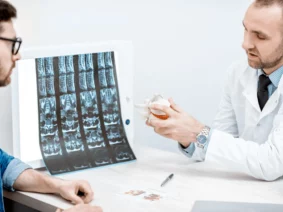A person sustains a spinal compression fracture when the vertebrae in the spine are squashed and collapse. Technically, the condition is defined as a vertebral spinal bone that has decreased by 15 to 20 percent in height due to a fracture. This type of spinal fracture is typically caused by osteoporosis (loss of bone mass), a result of aging. With weakened bone mass, a fall, lifting a heavy object or even coughing can possibly result in a spinal fracture. In addition, spinal compression fractures can also happen to others due to falls or trauma. Metastatic tumors, common in the spine with the spread of cancer, are often considered as the cause of spinal compression fractures in those under age 55 with no trauma history to the area.
The majority of spinal compression fractures tend to be located in the upper thoracic spine (upper back), or they can be in the lumbar spine (lower back). Although these fractures rarely occur in the upper back, technically they can occur anywhere in the spine. Problematically, these fractures can be missed or misdiagnosed, confused for general back pain or symptoms considered a normal part of aging. Consequently, a majority of these fractures go untreated. What’s more, those who have had a compression fracture are likely to have more.
Risk in Both Women and Men
Osteoporosis, the main cause of a spinal compression fracture, is particularly common in women after menopause. It is estimated that about 25 percent of post-menopausal women in the U.S. have had a vertebral (spinal) compression fracture.
While osteoporosis is often considered a woman’s condition, and impacts women four times more than men, nearly two million American men also have osteoporosis (with millions more at risk of the disease), with an equivalent risk of bone fractures as that of women.
Types of Compression Fractures
Spinal compression fractures can be referred to by other names, including vertebral fracture, osteoporotic fracture or wedge fracture. In a wedge fracture, the break occurs in the front of the vertebra, collapsing the bone in the front and creating a wedge shape. This fracture–the most common type of compression fracture–is considered to be mechanically stable. There are other types of spinal decompression fractures. These include:
Crush fracture–when the entire bone breaks, not only the front of the vertebra
Burst–when both the front and back of the vertebra indicate a break, causing loss of spinal height; must be differentiated from other types because it may be unstable, a risk for further deformity or other problems
Symptoms
Symptoms of a spinal compression fracture include:
- Sudden and/or severe back pain
- Pain, numbness or weakness in arms or legs
- Worsening pain when standing or walking
- Difficulty and pain when bending, twisting or lifting
- Limited spinal mobility
- Hunchback-like curving of the spine (in patients with osteoporosis)
- Loss of height
Treatment
Compression fractures typically heal on their own within two to three months. Nonsurgical treatment usually involves alleviating pain with rest, pain medication and possibly the use of ice or heat for localized pain and following injury prevention strategies.
In the event surgery is indicated (such as for spinal instability), two common procedures are:
Vertebroplasty. This is a minimally invasive surgery done with X-ray guidance and a small needle. A bone cement is injected into the collapsed vertebra, which quickly hardens and serves to stabilize the fracture through mechanical support.
Kyphoplasty. This is similar to vertebroplasty, but prior to the injection of bone cement, two small incisions are made. Two balloons are then inserted and inflated in order to expand spaces into which the cement is filled. This provides the added benefit of restoring height to the spine.
Our experts at Neurosurgical Associates of Central Jersey are widely experienced with spinal compression fractures. For more information, or to schedule an appointment with a specialist, contact us today.



